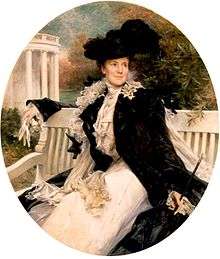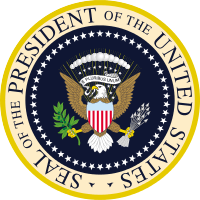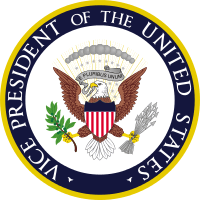Edith Roosevelt
| Edith Roosevelt | |
|---|---|
 | |
| First Lady of the United States | |
|
In role September 14, 1901 – March 4, 1909 | |
| President | Theodore Roosevelt |
| Preceded by | Ida McKinley |
| Succeeded by | Helen Taft |
| Second Lady of the United States | |
|
In role March 4, 1901 – September 14, 1901 | |
| President | William McKinley |
| Preceded by | Jennie Hobart (1899) |
| Succeeded by | Cornelia Fairbanks (1905) |
| First Lady of New York | |
|
In role January 1, 1899 – December 31, 1900 | |
| Governor | Theodore Roosevelt |
| Preceded by | Lois Black |
| Succeeded by | Linda Odell |
| Personal details | |
| Born |
Edith Kermit Carow August 6, 1861 Norwich, Connecticut, U.S. |
| Died |
September 30, 1948 (aged 87) Oyster Bay, New York, U.S. |
| Spouse(s) | Theodore Roosevelt (1886–1919) |
| Children |
Theodore Kermit Ethel Archibald Quentin |
| Religion | Episcopalian |
| Signature |
|
Edith Kermit Carow Roosevelt (August 6, 1861 – September 30, 1948) was the second wife of President Theodore Roosevelt and served as First Lady of the United States during his presidency from 1901 to 1909. She was the first First Lady to employ a full-time, salaried social secretary. Her tenure resulted in the creation of an official staff, and her formal dinners and ceremonial processions served to elevate the position of First Lady.
Early life
Edith was born in Norwich, Connecticut, to merchant Charles Carow (1825–1883) and Gertrude Elizabeth Tyler (1836–1895).[1][2] Gertrude's father Daniel Tyler (1799–1882) served as Union general in the American Civil War.[1]
Edith's younger sister was Emily Tyler Carow (1865—1939).[3] Edith also had a brother, Kermit (February 1860 — August 1860) who died one year before her birth.[4]
During her childhood, Edith was known as "Spotless Edie."[1]
Edith grew up in brownstone on Union Square in New York City.[5] Next door lived Theodore "Teddy" Roosevelt (1858–1919). Edith was best friends with his younger sister Corinne (1861–1933).[6]
Edith, Corrinne, Teddy, and Elliot did their earliest school together at the Roosevelt family home at 28 East 20th Street.[1] Edith later attended Miss Comstock's finishing school.[5]
Although Edith and Teddy may have had a teenage romance, the relationship faded when Teddy went to Harvard University.[2][6] While at Harvard, Teddy met Alice Lee.[6] Teddy and Alice married in 1880.[6] Edith attended the wedding.[5]
Marriage
Alice Lee died in 1884, leaving behind a baby daughter also named Alice. Teddy and Edith rekindled their relationship in 1885.[2] They married in London on December 2, 1886.[6] Teddy's best man was Cecil Spring Rice, who later served as British ambassador to the United States during World War I and maintained a close friendship with the couple for the rest of his life.[7]
After their honeymoon, the couple lived at Sagamore Hill on Long Island, New York.[6]
Together the couple raised Alice (Teddy's daughter from his previous marriage) and their own children: Theodore (1887), Kermit (1889), Ethel (1891), Archibald (1894), and Quentin (1897).[6]
In 1888, Theodore was appointed to the United States Civil Service Commission, where he served until 1895. While Edith supported her husband's decision to accept the position, she lamented that her third pregnancy would detain her at Sagamore Hill.[8] Kermit Roosevelt was born on October 10, 1889 and three months later Edith moved to Washington with her children.[8] During this period, Edith and Henry Adams became close friends.[8]
At Edith's insistence, Theodore did not run for mayor of New York in 1894, because Edith preferred their life in Washington, D.C., and his job of U.S. Civil Service Commissioner.[6]
When Theodore became New York City police commissioner in 1895, they moved to New York City.[1] In 1897, Teddy was chosen as assistant secretary of the Navy and the family moved back to Washington.[1]
In 1898, Edith traveled by train to Tampa, Florida to send her husband off to fight in the Spanish-American War.[2]
Upon his return from Cuba, Edith defied a quarantine to meet him in Montauk, New York, where she assisted veterans at the hospital. In October 1898, when Roosevelt was nominated for the governorship, Edith helped answer his mail, but stayed off the campaign trail.[6]
First Lady of New York
Edith Roosevelt enjoyed being First Lady of New York. She modernized the governor’s mansion, joined a local woman’s club, and continued to assist with her husband’s correspondence.[6] While First Lady of New York, Edith began a tradition that should would continue in the White House-she held a bouquet of flowers in each hand. Edith found shaking a stranger's hand overly familiar and preferred to bow her head in greeting.[2]
Edith moved back to Washington when Roosevelt won the vice presidency in 1900.[6]
First Lady

After President McKinley’s assassination, Teddy assumed the presidency, and Edith became First Lady.[6]
With the country in mourning, the new First Lady could not do any entertaining. Instead Edith focused on how to fit her large family into the White House. Edith eliminated the office of housekeeper, performing the supervisory work herself.[8]
Edith made a major institutional change when she hired Isabelle Hagner as the first social secretary to serve a First Lady.[8] Hagner's initial assignment was to plan Alice Roosevelt's debut in 1902.[8] Edith soon began to rely on Hagner and authorized her to release photos of the first family in hopes of avoiding unauthorized candids.[8]
Edith built on the First Lady's long history of entertaining visitors and made the First Lady the nation's hostess.[2] She expanded the number of social events held at the White House, ensured her parties were not outshone by the parties of Cabinet wives, and worked to make Washington the nation's cultural center.[2] The two most significant social events during Edith's tenure as First Lady were the wedding of her stepdaughter, Alice Roosevelt, and the society debut of her daughter, Ethel Roosevelt.[9]
Edith also organized the wives of the cabinet officers and tried to govern the moral conduct of Washington society through their guest lists.[9]
Edith is believed to have exerted subtle influence over her husband.[8] She and Teddy met privately every day from 8 to 9 am.[8] The President's assistant, William Loeb often helped sway Teddy to Edith's way of thinking.[8] Edith read several newspapers a day and forwarded clippings she considered important to her husband.[2] In a 1933 article in the Boston Transcript, Isabelle Hagner reported that the legislation which created the National Portrait Gallery was passed because of Edith's influence.[8] Historians believe her most important historical contribution was acting as an informal liason between Teddy and British diplomat Cecil Spring Rice which gave Teddy unoffical information about the Russo-Japaense War.[10] As a result of negotiating the treaty which ended that conflict, Teddy won the Nobel Peace Prize in 1906.[10]
Teddy and Edith became the first President and First Lady to travel abroad while office when they made a trip to Panama.[11]
A perceptive aide described the First Lady as "always the gentle, high-bred hostess; smiling often at what went on about her, yet never critical of the ignorant and tolerant always of the little insincerities of political life."[5]
In 1905, Edith purchased Pine Knot, a cabin in rural Virginia, as a refuge for Teddy.[6][9] At Pine Knot, the Secret Service guarded the President without his knowledge.[10]
White House renovation

In 1902, Edith hired McKim, Meade & White to separate the living quarters from the offices, to enlarge and modernize the public rooms, to re-do the landscaping, and to redecorate the interior.[6] Congress approved over half a million dollars for the renovation.[8] The new West Wing housed offices while the East Wing housed the First Family and guests.[8] The plumbing, lighting, and heating were upgraded.[8] Edith placed her office next door to Teddy's so that they could confer frequently throughout the day.[9]
Edith took a historical view of the White House[10] and saw that the Green Room, Blue Room, and East Room were redecorated with period antiques.[9] McKim would have removed most of the existing furniture had Edith not intervened.[12] It is because of Edith's intervention that the Victorian furniture currently seen in the Lincoln Bedroom was retained.[12]
A larger dinning room translated into a need for more china, so Edith ordered a Wedgwood service with the Great Seal of the United States for 120 people.[8][9] Interest in her own china fostered a curiosity about the services of previous First Ladies.[9] Edith completed the catalog of White House china begun by Caroline Scott Harrison.[2] She added to the collection by purchasing missing items from antique shops and by the time she left the White House, their were pieces from twenty-five administrations.[2] She created a display of the China on the ground floor of the White House.[10] The White House China collected which was first exhibited by Edith Roosevelt is still on view today.[8]
Across from the White House China, Edith displayed portraits of former First Ladies. The formerly scattered portraits were a hit with the public. Now guests to the White House could view the historical china and portraits as they waited to enter receptions.[8]
Edith called on former White House gardener Henry Pfister to help her design a colonial garden on the west side of the White House.[12] A similiar garden was eventually placed on the east side of the White House.[12]
The White House renovations were revealed to the public during the 1903 New Year's Day reception.[9]
It was during Edith's tenure as First Lady that the White House became known as the White House. Previously, it had been known as the Executive Mansion.[10][13]
Relationship with her children

Edith was a devoted mother. She spent several hours a day with her children[2] and read to them daily.[14] The President and First Lady took an active role in their children's education and often corresponded with their children's teacher.[11]
Edith longed for more children even after the birth of her fifth child, Archie.[8] She suffered two miscarriages as First Lady.[8]
Edith had a complicated relationship with her step-daughter Alice.[2] In later years, Alice expressed admiration for her stepmother's sense of humor and stated that they had shared similar literary tastes. In her autobiography Crowded Hours, Alice wrote of Edith, "That I was the child of another marriage was a simple fact and made a situation that had to be coped with, and Mother coped with it with a fairness and charm and intelligence which she has to a greater degree than almost any one else I know."[15]
Views on race
On October 16, 1901,[1] Teddy Roosevelt invited African-American educator Booker T. Washington to dine with his family at the White House. Several other presidents had invited African-Americans to meetings at the White House, but never to a meal.[16] News of the dinner between a former slave and the president of the United States became a national sensation. The subject of inflammatory articles and cartoons, it shifted the national conversation around race at the time.[16] Some Republicans tried to spin the dinner into a lunch. As Deborah Davis explained on NPR, "they got hungry and they ordered a tray. and by the time they were finished, there was barely a sandwich on it. And that seemed to make the meal a little more palatable in the South."[16] The lunch story persisted for decades, until finally in the 1930s, a journalist from Baltimore's Afro-American newspaper asked Edith Roosevelt if it was lunch or dinner. Edith checked her calendar, and she said it was most definitely dinner.[2]
Among the responses to the dinner was a cartoon created by Maryland Democrats in which Edith sat between Teddy and Booker.[2] The cartoon was widely reprinted.[2] According to Deborah Davis, this was the first time that a First Lady was lampooned in print.[2]
The dinner secured Washington's position as the leading black figure and spokesman in the United States.[17] From there, Washington became an adviser to Roosevelt on race politics and Southern politics in general.[17] While Teddy did appoint a few offices to black politicians and he admired a few exceptional black men such as Washington, Teddy generally held the same racist attitudes common to many white Americans of the day.[17]
Deborah Davis believes that Edith admired Booker T. Washington.[2] In a March 1901 letter, Teddy wrote to Booker, "Mrs. Roosevelt is as pleased as I am with your book."[2]
According to biographer Lewis Gould, careful reading of Edith's private correspondence reveals racial views that go beyond what he calls the “genteel bigotry” of her time.[18] In 1902 and 1903 "Misses Turner and Miss Leech" performed at the Roosevelt White House. The women specialized in "Negro Songs" and Lewis Gould argued that by showcasing these performers, Edith entertained "guests with crude melodic stereotypes depicting an oppressed racial minority."[2]
Later life and death
_(13566050043).jpg)
Edith's last decades were full of travel: to Europe, Asia, Africa, and South America. After leaving the White House, Teddy and Kermit went on a safari[2] while Edith took Ethel, Archie, and Quentin on an extended tour of Europe.[6]
The Smithsonian’s First Lady collection was created soon after the Roosevelts left the White House. When the museum’s advocates asked her for a contribution, Edith said that she wasn’t sure she could help: she often cut up dresses for the material after she wore them. Turns out her inaugural gown was no exception. Her daughter later donated the remaining bottom half, and the Smithsonian refashioned the bodice using photographs.[19]
Edith was not an advocate of Teddy’s 1912 third-party presidential race, but supported him fully when it was formally underway. She tended him after the assassination attempt, consoled him when he lost the election, and accompanied him to Brazil to see him off as he explored the River of Doubt.[6]
Both Roosevelts contributed to home-front activities during World War I.[6]
Edith urged Republican women to vote after the 19th Amendment passed.[6]
During the Great Depression, Edith campaigned briefly for Herbert Hoover, to emphasize that the Democratic nominee, Franklin Roosevelt, was not her son.[6] Edith loved Eleanor, but there had been bad blood between the two since the 1920s when Eleanor campaigned against Theodore Roosevelt Jr. during his run for governor of New York.[14]
Before her death, Edith destroyed almost all of her correspondence with Teddy.[2] However, Edith was a prodigious letter writer and her letters survive in archives such as the Houghton Library.[2]
Edith died on September 30, 1948, at the age of 87.[5] She is buried in Oyster Bay, NY.[20]
References
- 1 2 3 4 5 6 7 Morris, Sylvia (2009-02-19). Edith Kermit Roosevelt: Portrait of a First Lady. Random House Publishing Group. ISBN 9780307522771.
- 1 2 3 4 5 6 7 8 9 10 11 12 13 14 15 16 17 18 19 20 21 22 Sibley, Katherine A. S. (2016-03-14). A Companion to First Ladies. John Wiley & Sons. ISBN 9781118732182.
- ↑ "TR Center - Emily Tyler Carow". www.theodorerooseveltcenter.org. Retrieved 2016-11-30.
- ↑ "Robert Kermit Carow b. 26 Feb 1860 Norwich, New London, Connecticut, United States d. 25 Aug 1860 Norwich, New London, Connecticut, United States: Our Family History". hughesfamilygenealogy.com. Retrieved 2016-11-30.
- 1 2 3 4 5 "Edith Kermit Carow Roosevelt". whitehouse.gov. 2014-12-31. Retrieved 2016-11-30.
- 1 2 3 4 5 6 7 8 9 10 11 12 13 14 15 16 17 18 19 "TR Center - Edith Kermit Carow Roosevelt". www.theodorerooseveltcenter.org. Retrieved 2016-11-30.
- ↑ S. Gwynn, 'The Letters and Friendships of Sir Cecil Spring Rice' (Constable & Co Lt, London, 1929), 121.
- 1 2 3 4 5 6 7 8 9 10 11 12 13 14 15 16 17 18 19 Gould, Lewis L. (2014-02-04). American First Ladies: Their Lives and Their Legacy. Routledge. ISBN 9781135311551.
- 1 2 3 4 5 6 7 8 "Edith Roosevelt—Miller Center". millercenter.org. Retrieved 2016-11-30.
- 1 2 3 4 5 6 Hendricks, Nancy (2015-10-13). America's First Ladies: A Historical Encyclopedia and Primary Document Collection of the Remarkable Women of the White House: A Historical Encyclopedia and Primary Document Collection of the Remarkable Women of the White House. ABC-CLIO. ISBN 9781610698832.
- 1 2 Watson, Robert P. (2012-02-01). Life in the White House: A Social History of the First Family and the President's House. SUNY Press. ISBN 9780791485071.
- 1 2 3 4 Truman, Margaret (2007-12-18). The President's House: 1800 to the Present The Secrets and History of the World's Most Famous Home. Random House Publishing Group. ISBN 9780307417312.
- ↑ "First Lady - Edith Roosevelt | C-SPAN First Ladies: Influence & Image". firstladies.c-span.org. Retrieved 2016-11-30.
- 1 2 Harris, Bill; Ross, Laura (2013-02-01). First Ladies Fact Book -- Revised and Updated: The Childhoods, Courtships, Marriages, Campaigns, Accomplishments, and Legacies of Every First Lady from Martha Washington to Michelle Obama. Hachette Books. ISBN 9781603763134.
- ↑ Longworth, Alice Roosevelt (1980-01-01). Crowded Hours. Arno Press. ISBN 9780405128462.
- 1 2 3 "Teddy Roosevelt's 'Shocking' Dinner With Washington". NPR.org. Retrieved 2016-11-30.
- 1 2 3 "Booker T. Washington - Theodore Roosevelt Inaugural National Historic Site (U.S. National Park Service)". www.nps.gov. Retrieved 2016-11-30.
- ↑ "Edith Roosevelt's Views on Race". C-SPAN.org. Retrieved 2016-11-30.
- ↑ Steinmetz, Katy. "Belles of the Ball: An Insider's Look at Inaugural Gowns". Time. ISSN 0040-781X. Retrieved 2016-11-30.
- ↑ "Edith Kermit Carow Roosevelt (1861 - 1948) - Find A Grave Memorial". www.findagrave.com. Retrieved 2016-11-30.
External links
- Works by or about Edith Roosevelt at Internet Archive
- Edith Roosevelt at C-SPAN's First Ladies: Influence & Image
| Honorary titles | ||
|---|---|---|
| Preceded by Lois Black |
First Lady of New York 1899–1900 |
Succeeded by Linda Odell |
| Vacant Title last held by Jennie Hobart |
Second Lady of the United States 1901 |
Vacant Title next held by Cornelia Fairbanks |
| Preceded by Ida McKinley |
First Lady of the United States 1901–1909 |
Succeeded by Helen Taft |

